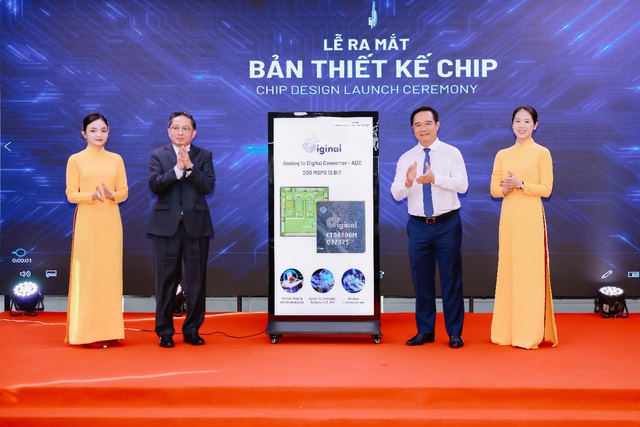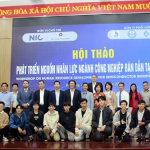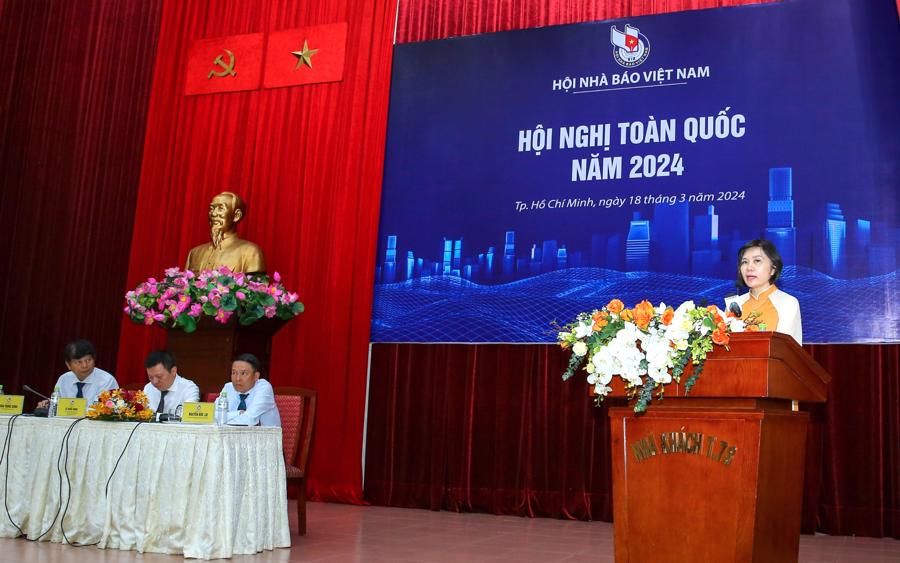A significant event was the launch of the Vietnamese-designed IoT chip, designed by engineers of the Corporation using semiconductor chip design technology with CMOS and III/V Semi semiconductor technologies. The event took place on June 29, 2025, in Ho Chi Minh City. CT Group is developing chip design centers (chip design houses) focusing on researching and designing AI chips, IoT chips, and application-specific chips in various fields such as UAVs, National Defense, 5G/6G, AI, sensors, and IoT. The group is also developing IP cores and functional modules for use in SoC design, aiming for self-sufficiency in chip design.

Comrade Nguyen Van Duoc – Member of the Party Central Committee, Vice Secretary of the City Party Committee, and Chairman of Ho Chi Minh City People’s Committee (right) and Mr. Tran Kim Chung – Chairman of CT Group at the Launch Ceremony of the Vietnamese IoT Chip Design
CT Group also aims to master semiconductor chip etching technology. Currently, we are following the fabless approach (domestic design and overseas etching), building an etching collaboration network with leading global partners. CT Group is building a team of engineers capable of mastering semiconductor chip etching technology, along with domestic and overseas experts. We propose a plan for mastering etching technology, suggesting that the government invests in etching machines while enterprises operate and develop the technology. Given the opportunity, from now until 2030, the Corporation aims to perfect the entire process from design to etching, assembly, packaging, and testing of semiconductor chips included in the list of strategic technology products and chips related to security, national defense, and security to ensure chip security for Vietnam. In terms of assembly, packaging, and testing technology, CT Group has established a chip assembly, packaging, and testing factory, gradually mastering the entire process.
CT Semiconductor, a member of the CT Group, specializes in ATP (Assembly, Testing, and Packaging) and is developing three ATP factories (two in the South and one in the North), two R&D centers (in Ho Chi Minh City and Hanoi), and two customer care centers in Silicon Valley and Phoenix.
Market advantages: We have ready outlets in the UAV, IoT, near-space economy, Ministry of National Defense, and Ministry of Public Security sectors. We are also developing a smart city ecosystem, including sensors, AI cameras, energy control modules, and intelligent monitoring systems, which have a high demand for AI and IoT chips. CT UAV, a pioneer in the UAV industry, also offers a direct market for testing and applying specialized chips for unmanned aerial vehicles and AI chips. As a diversified conglomerate with a diverse ecosystem and global network of partners, we are well-positioned to capitalize on these advantages.
Human resource advantages: Our team of engineers has extensive experience in semiconductor chip design. We collaborate with major universities such as Ho Chi Minh City University of Technology and Can Tho University to train and develop human resources. We have also accessed many domestic, overseas Vietnamese, and international expert teams in the field of chip design, serving as high-level technical advisors.
Infrastructure advantages: Supported by CT Group’s ecosystem, including research centers, production facilities, and training institutes; the ATP factory is ready for chip packaging and testing.
Other advantages: Strategic advantages with a commitment to long-term and methodical investment in the semiconductor industry, with a roadmap for developing chips in strategic areas such as telecommunications, AI, IoT, UAV, and 5G/6G, in line with the government’s orientation for developing the semiconductor industry.
Currently, CT Group has the capability to design complex chips using advanced 2nm CMOS technology. When asked about Chip ADC/DAC on Chat GPT, it was emphasized that these components are crucial in all smart electronic devices. ADC converts signals from sensors like temperature, sound, and light into digital data for computer or chip processing. Conversely, DAC transforms digital data into analog signals to control speakers, motors, and external devices. Without ADC and DAC, modern processing chips like microprocessors and AI chips would struggle to interact with the physical world.
These converters are widely used in critical sectors such as healthcare (ultrasound machines, heart rate monitors), defense (radar, weapon control systems), smart agriculture (environmental sensors, automatic irrigation), smart automobiles (cameras, LiDAR sensors), and compact AI devices like microphones and smart speakers.
Additionally, CT Group proposed selecting April 30, 2025, as Vietnam Semiconductor Day to affirm the strength of national unity in the country’s new development phase.
Semiconductor Workforce Development Initiative Needs ‘Package’ of Disruptive Policies, Mechanisms
Chairing the working session on the “Development of Semiconductor Industry Human Resources to 2030, with a Vision to 2045” Project on the morning of April 22, Deputy Prime Minister Tran Hong Ha emphasized that the Project is of great importance, requiring a strategic vision and a thorough understanding of the close relationship between the electronics industry and the semiconductor industry, the requirements for human resources, the stages of design, manufacturing, and use of microchip and semiconductor products, etc.








![[Photo Essay]: Experts, Managers, and Businesses Unite to Forge a Path Towards Sustainable Green Industry](https://xe.today/wp-content/uploads/2025/07/z678592918-150x150.jpg)


![[Photo Essay]: Experts, Managers, and Businesses Unite to Forge a Path Towards Sustainable Green Industry](https://xe.today/wp-content/uploads/2025/07/z678592918-100x70.jpg)






